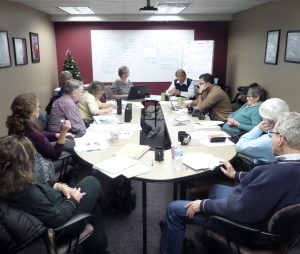The Meeting.
Saturday, I participated in a planning meeting of an organization I’ve been part of for 13 years. A dozen of us – half male, half female – spent six hours talking about the things that generally go into organizations of all sorts. If we look tired in the above photo, it’s because we are. It is hard work to plan. We all stuck with the task and the process.
It was, I felt, an excellent meeting.
What was unusual about this meeting, at least in my personal context of many years in organizations, is that the motivation came from the single youngest member of the group, under 30. The rest of us were considerably older.
Sitting around that table was a great deal of talent, and hard-work – people who have worked in different ways in different arenas for many years. Our common thread, including the name and the history of the organization are irrelevant to this post.
A main theme – at least for me – in the present day is the fact that the elders and the youngers communicate in very different ways. We’re in something of a “wild west”, still, in communications. So, for instance, our long time newsletter was always mailed to a mailing list, and never, ever included things like e-mail addresses and web links.
These days an organization does not long survive without recognizing and using technology.
So, we elders now have a newly designed website amenable to younger persons, and we include links in the newsletter. Even so, we’re behind the times…though we’re making progress. Our youthful leader has indicated more than once that websites themselves are of limited value to younger people, who identify and act on issues in ways even the technologically astute among we elders hardly understand.
This creates dilemmas.
In our group, we have a very proud history that goes back, as we say in our newsletter, 70 years this year. This institutional history is something unwise to be discarded.
On the other hand, if we don’t work hard to cross the canyon to the youth who have similar interests to our own, we are in deep trouble in the long term, and so are the youngers who can learn something from us.
I could generate a much longer list of things organizations like ours need to contend with in the present day.
We adjourned our meeting about 20 minutes or so after I took the photo which leads this blog.
We adjourned with a framework that we now can work from and develop over the coming months and years…if we choose to take the bait.
The task is daunting.
Each issue of our newsletter for many years has included a quotation on the mailing panel.
At Saturdays meeting we prepared for mailing the current newsletter, which includes a quote from 2004 Nobel Peace Prize Winner Wangari Maathai, which seems to fit the task ahead for all of us: “Every one of us can make a contribution. And quite often we are looking for the big things and forget that wherever we are we can make a contribution. Sometimes I tell myself, I may only be planting a tree here, but just imagine what’s happening if there are billions of people out there doing something. Just imagine the power of what we can do.”
I’m glad I attended yesterdays meeting. I wish us the stamina to follow Wangari Maathai’s advice.
COMMENTS:
from Chuck, Jan 8: I read your blog about the long meeting. I feel your pain. I’ve been through many like that. Guess what. Not much has changed….while everything has changed.
I’ve been focused in on the value of engineering. Be it a dam, a nuclear power plant, a house, a human body, a government…
And what I’ve only recently come to understand (thanks to a Nuclear Engineer with 30 years’ experience as a Government whistleblower – they can’t get rid of) is that EVERYTHING is made up of three things.
Systems, Structures, and Fundamental principles.
And, if somethings not working or fails catastrophically…it’s because some fundamental principles were not followed, or the system and/or structure was fundamentally flawed to begin with.
Regarding planning meetings in general.
1. Humans (meeting structures) are all fundamentally flawed. (we can believe anything, not do what we know we should do, limited in capacity to understand all the connections/consequences to our actions…)
2. Meetings (human systems) are usually flawed.
3. Plans (structures to implement systems so bigger systems and structures can work well) are usually made by humans who rarely follow them for any number of valid/invalid or good/ bad reasons.
4. You get fatter and older and sometimes wiser.
Right now I think planning is relatively useless because of the pace of change is accelerating…while the pace of human mind changing appears to be frozen. At least the pace of government change appears to be picking up…for better or worse.
Predicting which? Not gonna try…but I’m guessing for the worst…and hoping for the better.
One thing that does stay the same. Members of Congress want to look good to the majority of their voters and get reelected. Our role as citizens is to provide constant adult supervision.


Leave a Reply
Want to join the discussion?Feel free to contribute!